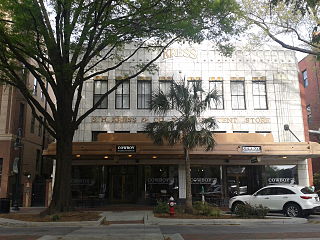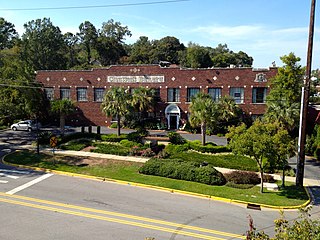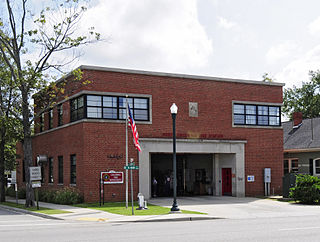
Sylvan Building, originally known as Central National Bank, is a historic commercial building located at Columbia, South Carolina. It was built in 1870, and is a three-story, brick Second Empire style building designed by Samuel Sloan. It features a slate-covered mansard roof.

Town Theatre is a historic community theatre located at Columbia, South Carolina. It was built in 1924, and is a rectangular brick building with a two-story glazed central arch with Art Deco influences. A brick annex was added to the rear of the building in the 1950s. It houses one of the first community theatres in the United States.

Building at 1210-1214 Main Street, also known as Capitol Café, is a historic commercial building located at Columbia, South Carolina. It was built by 1871, and is a two-story, seven bay, stuccoed brick building. A cast-iron railing extends across central three bays of the second floor. The Capitol Café has been located in the building since 1913.

Lever Building is a historic commercial building located at Columbia, South Carolina. It was built in 1903, and is a three-story building faced with brown brick and terra cotta.

Consolidated Building is a historic commercial building located at Columbia, South Carolina. It was built in 1912, and is a two-story building faced with elaborate colored and glazed terra cotta. The second floor features a central tripartite round-headed window.

Kress Building is a historic commercial building located at Columbia, South Carolina. It was built in 1934 by S. H. Kress & Co., and is a two-story, Art Deco style building faced with white terra cotta and colored terra cotta ornamentation. It features rounded storefront windows and cornice that contains the word "Kress" and surmounted by a stepped parapet.

National Loan and Exchange Bank Building, also known as the Barringer Building, is a historic bank and office building located at Columbia, South Carolina. It was built in 1903, and is a 12-story, steel frame building faced in brick and stone. It measures 184 feet high and is considered Columbia's first skyscraper. The building was owned by the Barringer Corporation from 1953 until 1974.

Canal Dime Savings Bank, also known as Eckerd's Drug Store, is a historic bank building located at Columbia, South Carolina. It was built between 1892 and 1895, and is a three-story, Romanesque Revival style brick building with a granite façade and red barrel tile roof. The building was purchased by Eckerd's Drug Store in 1936.

Confederate Printing Plant is a historic industrial building located at Columbia, South Carolina. It was built in 1864, and is a large two-story, Greek Revival style brick structure. Originally it was a one-story structure, but enlarged to two-stories after the building was burned in February 1865 by General William Tecumseh Sherman’s army. It was built by the Evans and Cogswell Company for the manufacture of Confederate bonds and other printing purposes. During the 20th century, it was used as a liquor warehouse by the South Carolina Dispensary and is presently used as a Publix grocery store and residential condominiums.

Building at 303 Saluda Avenue, also known as John C. Heslep House, is a historic home located at Columbia, South Carolina. It was built about 1917 as a two-story brick residence, then remodeled and rebuilt in the Spanish Colonial Revival style in 1927-1928. It features a low-pitched tile roof, coarse stucco walls, and cast iron balconies. Also on the property is a contributing guest house.

Richland Cotton Mill, also known as Pacific Mills, Lowenstein Mill, and Whaley's Mill, is a historic cotton mill building located at Columbia, South Carolina. It was built in 1894, and is a four-story, rectangular brick mill building. It features a seven-story stair tower, with a circular vent flanked by two arched vents. Attached to the building are an engine room, a boiler room with chimney, and a machine shop.

Palmetto Compress and Warehouse Company Building is a historic cotton bale compress facility and warehouse building located at Columbia, South Carolina. The first section of the four-story brick building was built in 1917. The building was doubled in size in 1923.

Olympia Mill, also known as Pacific Mill, is a historic textile mill complex located at Columbia, South Carolina. It was built in 1899, and consists of a four-story, red brick, rectangular shaped, main mill building connected to a one and two-story red brick power plant. The main building is in the Romanesque Revival style and features terra cotta detailing, large segmental arched window openings, and twin pyramidal roofed towers. The complex also includes: a one-story brick power plant auxiliary building, a one-story storage building, and two small brick one-story gatehouses.

Claussen's Bakery, also known as Claussen's Inn, is a historic commercial bakery located at Columbia, South Carolina. It was built in 1928, and is a two-story, trapezoidal plan, brick building that contains a total of 25,000 square feet. The Columbia bakery ceased operating in 1963. It was later converted to a boutique hotel.

North Columbia Fire Station No. 7 is a historic fire station located at Columbia, South Carolina. It was built in 1948, and is a two-story, brick, transitional Art Moderne / International style building. It features metal window frames, flat roof, and corner ribbon windows.

Harden Street Substation, also known as Harden Street Fire Station, is a historic fire station located at Columbia, South Carolina. It was built in 1953, and is a two-story, rectangular brick building with a flat roof constructed in the Moderne style. It was built by the city of Columbia to house African-American firemen under white officers and maintain institutional segregation.

A.P. Williams Funeral Home is a historic African-American funeral home located at Columbia, South Carolina. It was built between 1893 and 1911 as a single-family residence, and is a two-story frame building with a hipped roof with gables and a columned porch. At that time, it was one of six funeral homes that served black customers. Archie Preston Williams, II was a leader in the city's black community.

Columbia Central Fire Station, also known as Columbia Fire Department Headquarters and Senate Street Station, is a historic fire station located at Columbia, South Carolina. It was built between 1949 and 1951, and consists of two buildings and a structure. The main building is a two-story, rectangular, brick building in the Moderne / International Style. It has a flat roof and features horizontal bands of windows. The one-story, brick fire truck garage building and the main building were constructed in 1949-1950. The drill tower is a six-story reinforced concrete structure built in 1951. The complex served as the Columbia Fire Department's Headquarters from 1950 until 1995.

Granby Mill Village Historic District is a national historic district located at Columbia, South Carolina. The district encompasses 97 contributing buildings associated with a cotton mill and associated mill village. The mill was initially constructed in 1896-1897, and is a large four-story, rectangular brick building in the Romanesque Revival style. It features two projecting five-story entrance towers. The Granby Mill Village includes a number of "saltbox" style dwellings reminiscent of a New England mill village. The district also includes the mill gatehouse, the two-story mill office building, commercial buildings, the Gothic Revival style Whaley Street Methodist Church, and operatives' houses.

People's National Bank Building, also known as Franklin's Clothing Store, is a historic bank building located at Rock Hill, South Carolina. It was built about 1909–1910, and is a four-story brick building, plus basement. It was the first building in the city constructed as a speculative office building, the first with a passenger elevator, and the tallest commercial building in Rock Hill. The People's National Bank merged with Citizens and Southern National Bank of South Carolina in 1964 and moved out of the building in 1972.


























